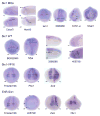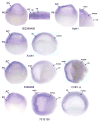Microarray identification of novel genes downstream of Six1, a critical factor in cranial placode, somite, and kidney development
- PMID: 25403746
- PMCID: PMC4428348
- DOI: 10.1002/dvdy.24229
Microarray identification of novel genes downstream of Six1, a critical factor in cranial placode, somite, and kidney development
Abstract
Background: Six1 plays an important role in the development of several vertebrate organs, including cranial sensory placodes, somites, and kidney. Although Six1 mutations cause one form of branchio-otic syndrome (BOS), the responsible gene in many patients has not been identified; genes that act downstream of Six1 are potential BOS candidates.
Results: We sought to identify novel genes expressed during placode, somite and kidney development by comparing gene expression between control and Six1-expressing ectodermal explants. The expression patterns of 19 of the significantly up-regulated and 11 of the significantly down-regulated genes were assayed from cleavage to larval stages. A total of 28/30 genes are expressed in the otocyst, a structure that is functionally disrupted in BOS, and 26/30 genes are expressed in the nephric mesoderm, a structure that is functionally disrupted in the related branchio-otic-renal (BOR) syndrome. We also identified the chick homologues of five genes and show that they have conserved expression patterns.
Conclusions: Of the 30 genes selected for expression analyses, all are expressed at many of the developmental times and appropriate tissues to be regulated by Six1. Many have the potential to play a role in the disruption of hearing and kidney function seen in BOS/BOR patients.
Keywords: BOR syndrome; BOS syndrome; cranial ganglia; olfactory; otocyst; pan-placodal region; preplacodal ectoderm.
© 2014 Wiley Periodicals, Inc.
Figures
























Similar articles
-
Using Xenopus to discover new candidate genes involved in BOR and other congenital hearing loss syndromes.J Exp Zool B Mol Dev Evol. 2024 May;342(3):212-240. doi: 10.1002/jez.b.23222. Epub 2023 Oct 13. J Exp Zool B Mol Dev Evol. 2024. PMID: 37830236 Free PMC article. Review.
-
Six1 proteins with human branchio-oto-renal mutations differentially affect cranial gene expression and otic development.Dis Model Mech. 2020 Mar 3;13(3):dmm043489. doi: 10.1242/dmm.043489. Dis Model Mech. 2020. PMID: 31980437 Free PMC article.
-
Mcrs1 interacts with Six1 to influence early craniofacial and otic development.Dev Biol. 2020 Nov 1;467(1-2):39-50. doi: 10.1016/j.ydbio.2020.08.013. Epub 2020 Sep 3. Dev Biol. 2020. PMID: 32891623 Free PMC article.
-
Six1 and Irx1 have reciprocal interactions during cranial placode and otic vesicle formation.Dev Biol. 2019 Feb 1;446(1):68-79. doi: 10.1016/j.ydbio.2018.12.003. Epub 2018 Dec 6. Dev Biol. 2019. PMID: 30529252 Free PMC article.
-
Induction and specification of cranial placodes.Dev Biol. 2006 Jun 15;294(2):303-51. doi: 10.1016/j.ydbio.2006.03.009. Epub 2006 May 3. Dev Biol. 2006. PMID: 16677629 Review.
Cited by
-
Modeling congenital kidney diseases in Xenopus laevis.Dis Model Mech. 2019 Apr 9;12(4):dmm038604. doi: 10.1242/dmm.038604. Dis Model Mech. 2019. PMID: 30967415 Free PMC article. Review.
-
Generation of a new six1-null line in Xenopus tropicalis for study of development and congenital disease.Genesis. 2021 Dec;59(12):e23453. doi: 10.1002/dvg.23453. Epub 2021 Oct 19. Genesis. 2021. PMID: 34664392 Free PMC article.
-
The sulfotransferase XB5850668.L is required to apportion embryonic ectodermal domains.Dev Dyn. 2023 Dec;252(12):1407-1427. doi: 10.1002/dvdy.648. Epub 2023 Aug 19. Dev Dyn. 2023. PMID: 37597164 Free PMC article.
-
Morpholinos Do Not Elicit an Innate Immune Response during Early Xenopus Embryogenesis.Dev Cell. 2019 May 20;49(4):643-650.e3. doi: 10.1016/j.devcel.2019.04.019. Dev Cell. 2019. PMID: 31112700 Free PMC article. Review.
-
Using Xenopus to discover new candidate genes involved in BOR and other congenital hearing loss syndromes.J Exp Zool B Mol Dev Evol. 2024 May;342(3):212-240. doi: 10.1002/jez.b.23222. Epub 2023 Oct 13. J Exp Zool B Mol Dev Evol. 2024. PMID: 37830236 Free PMC article. Review.
References
-
- Abdelhak S, Kalatzis V, Heilig R, Compain S, Samson D, Vincent C, Weil D, Cruaud C, Sahly I, Leibovici M, Bitner-Glindzicz M, Francis M, Lacombe D, Vigneron J, Charachon R, Boven K, Bedbeder P, Van Regemorter N, Weissenbach J, Petit C. A human homologue of the Drosophila eyes absent gene underlies Branchio–Oto–Renal (BOR) syndrome and identifies a novel gene family. Nature Genet. 1997;15:157–164. - PubMed
-
- Ahrens K, Schlosser G. Tissues and signals involved in the induction of placodal Six1 expression in Xenopus laevis. Dev Biol. 2005;288:40–59. - PubMed
-
- Bailey AP, Streit A. Sensory organs: making and breaking the pre-placodal region. Curr Top Dev Biol. 2006;72:167–204. - PubMed
-
- Bailey AP, Bhattacharyya S, Bronner-Fraser M, Streit A. Lens specification is the ground state of all sensory placodes, from which FGF promotes olfactory identity. Dev Cell. 2006;11:505–517. - PubMed
Publication types
MeSH terms
Substances
Grants and funding
LinkOut - more resources
Full Text Sources
Other Literature Sources
Research Materials

